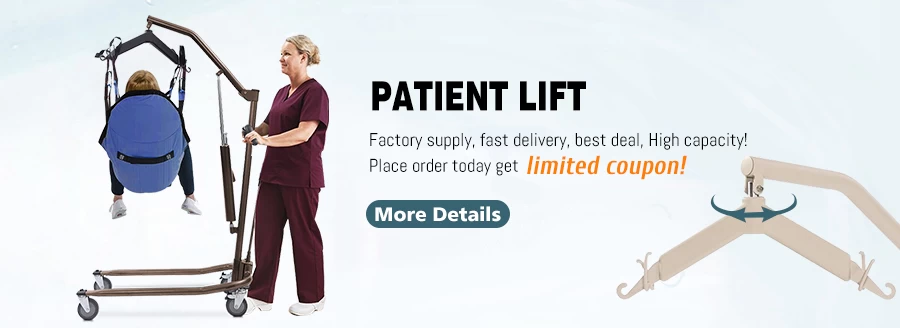- +86-138 4056 0445,+86-151 4027 2439
- info@careagemedical.com
Product Name: Hydraulic Patient Lift Product Model Number: 71910 Width: 590 mm Push Handle Height: 1140 mm Weight Limited: 150 kg
Product Name: Electric Patient Lift Product Model Number: 71970 Width: 590 mm Push Handle Height: 1140 mm Weight Limited: 150 kg
The electric patient lift which can easily move the patient up and down , saving effort and meeting the life needs of the patient. Transfers may be to and from beds, chairs, floor to bed, lateral transfers, bathing, and toileting , and offers a wide selection slings for a variety of lifting situations.

The following is a brief and basic guide to the different types of hoists that are available to help people with limited mobility, strength or co-ordination to relocate from one area to another. However, please note that every individual's needs are different and that carers risk injury if they do not observe correct moving and handling practices. Customers should base their purchasing decisions on the user's particular needs and preferences and, where appropriate, upon advice from medical and care professionals.
A patient hoist can take a number of forms but it is essentially a device for lifting and moving an individual who cannot walk independently. Common forms of hoist include overhead hoists - which run on ceiling tracks that extend between transfer positions or even rooms - and mobile hoists that move along the ground on wheels. Mobile patient hoists are usually the preferred choice as they have a wider range of use and can be used virtually anywhere. However, overhead hoists take up less floor-space. Bath hoists are also available.
A ceiling hoist represents a significant investment and might be installed as part of structural modifications to accommodate someone with a disability. Electrically powered, they run on overhead tracks that can incorporate multiple junctions, thereby giving access to all the places that the user needs to reach - such as the bed, bath, kitchen and living areas. The hoist itself is normally controlled with a simple handset and, when used in conjunction with a sling, it takes all the effort out of manual handling. Generally speaking, a ceiling hoist is used along tracking that is fixed to the ceiling by specialist installers. Where a ceiling doesn't have the necessary joists to fix into, there are alternative fixing to run wall to wall or to have a portable track.
Some ceiling hoists only lift and lower the user, so it is left to the carer to move the sling physically between rooms or living areas. Others, incorporate motors that will also drive the hoist laterally along the rails. Other variants include portable hoists that can be detached entirely from the track and put away or relocated for use elsewhere.
Important safety features include emergency stop buttons, circuit protection in case of overloading, battery power check and warning signals and manual overrides that allow the user to be lowered in case of electrical failure. Be sure to observe maximum load limits.
Where a fixed track to the ceiling is not possible, portable track is also available. Take, for example, the EasyTrack Freestanding system that can be used with an Oxford Voyager Portable Hoist. Many people who like to travel or stay in more than one location will invest in a portable system as they are designed to be easily set-up and transported.
Mobile hoists are generally less expensive than ceiling hoists but they are potentially more versatile because they are not limited to the extent of a ceiling track. Either electrically or hydraulically operated, they minimise the strain associated with lifting but they must be propelled manually from one area to another. Support from a carer is therefore essential.
Hydraulic versions require a little more effort to operate but are not dependent on batteries or a mains supply. Electric versions should come with a reliable, rechargeable battery and battery power indicators or warnings that help to prevent loss of power part-way through a manoeuvre. In all cases, mobile hoists are fitted with dependable brakes on the wheels. Note that some hoists, such as standing aids, will require some user participation so ensure their suitability before making any purchase.